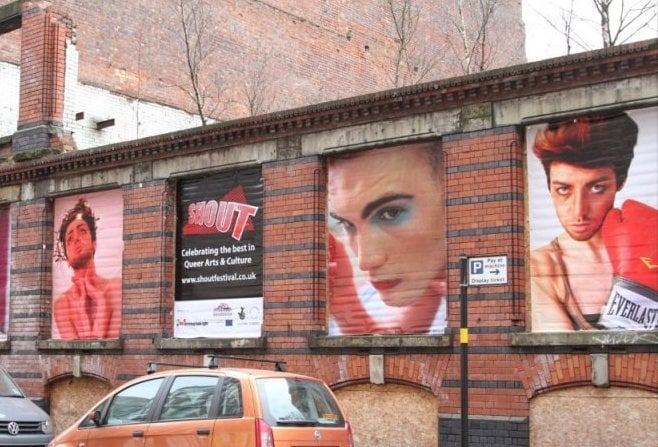
Photo: Nick Hynan
Shouting as loud as ever
Is an arts organisation dedicated to LGBT issues still necessary or even relevant? Yes, says Neil Anderson, so long as it moves with the times.
SHOUT has managed to deliver a programme every single year since its creation during a time when funding, participation and engagement in any form of cultural initiative (let alone one that consciously nurtures a niche audience) has been a highly sought-after prize. As I am responsible for the strategic direction, quality and audience development of this volunteer-led endeavour, I recently engaged in a passionate debate with one casual observer who thought that the recent past had been our “whisper years”, lamenting for an earlier time when we had delivered a month-long programme.
Queer festivals have the potential to move beyond the letters that make up the various acronyms of the LGBT communities and the themes, concerns and opportunities these groups face
That conversation took me back to our origins. Conceived in 2009 by the leading charity Birmingham LGBT, SHOUT grew out of a number of desires – at their heart individual and personal but also aspirational and ambitious. With an estimate that between 6 to 10% of the UK population identify as LGBT (a total population in our area the West Midlands of over 5.5 million people), that’s a lot of people either relying on Pride-type events or a diverse and inclusive cultural programme. There was also an implicit acknowledgment that as a major metropolitan centre, the West Midlands lacked its own dedicated and consistent queer cultural offering in the same vein as Homotopia in Liverpool and Glasgay, and that a regular event would help make a positive difference to Birmingham’s increasing reputation as an LGBT tourist destination.
All of these principles were woven within Birmingham LGBT’s organisational aims and objectives. As much as SHOUT was about more artistically driven goals, it would also stand for enriching the cultural offer of local LGBT people and using the arts as a vehicle to promote diversity and rights. While other queer festivals and LGBT arts projects have come and gone, this solid basis and vision means that we have been able to stay true to these goals while evolving and adapting to a changing world. Ultimately, this has meant surviving and continuing to deliver thought-provoking, entertaining and engaging work.
When we launched seven years ago with an intense 30-day programme on a cold and dark November night, it encouraged people to “come out, come out wherever you are!”. For the next two years this model continued, as the festival explored the theme of visibility and invisibility and encouraged the audience, venues and artists to look beyond initial perceptions and appreciate the world through the eyes of others. The last four years has seen us mature, grow and gain in confidence, requiring the need to find a balance between organisational development and delivery. From 2012 onwards we took the conscious decision to deliver more activity across each year – even if the bursts of activity were smaller in scale. This decision was partially in response to the funding environment but driven mainly by our volunteer basis and clear audience development goals. To become sustainable, a stop/start model of one large piece of activity each year meant a considerable amount of resources and energy were needed to re-engage the audience. As a result of this though, we have become more than just a queer festival. Throughout any given year we can be a film or a literature festival, be both visual and performing, populist and challenging, or simply a ‘badge’ desired by other organisations to promote their programming to a loyal and responsive audience.
Indeed, the brand that has now evolved has demonstrated that it retains a degree of depth, diversity, resilience and inclusivity and continues to celebrate and reflect these same qualities within the audiences it serves. As a concept, queer festivals have the potential to move beyond the letters that make up the various acronyms of the LGBT communities and the themes, concerns and opportunities these groups face.
While there is a still a considerable amount of work to do the world has moved on. There is a school of thought that LGBT activity is no longer relevant or needed. An example of this was in 2012 when the road movie Cloudburst won the audience choice award at our film festival. In the film the protagonists, an aging lesbian couple, are forced to flee to Canada to get married. The weekend before the opening of our festival, the US state that the film is set in legalised same-sex marriage – they could have got married at home instead.
While society’s reception and portrayals of LGBT have shifted in recent years, there are still unique challenges to respond to, stigmas to overcome and a recognition that while marriage is now possible, some can remember a dark period when who they were and who they wanted to be was against the law. Our recent thematic context examined this with ‘Generations and legacies’, exploring who we are, our wide-ranging age and backgrounds, where we’ve come from and what we leave behind.
A recent Arts Council England grant means that we have been able to recruit a dedicated member of staff who can focus on driving us forward and plan activities for the next 18 months. As we move through to our festival in November, we will continue to plan and adapt, knowing that we are now in a good place.
Neil Anderson is Chair of SHOUT’s steering group.
www.shoutfestival.co.uk
www.npanderson.co.uk
Tw @shoutfestival
Join the Discussion
You must be logged in to post a comment.